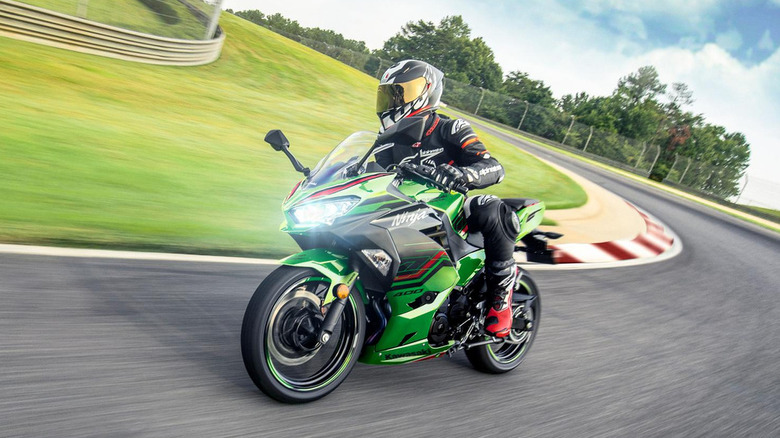How Fast Can The Kawasaki Ninja 400 Go? A Look At The Bike's Top Speed & Acceleration Times
Since its debut in 2018, the Kawasaki Ninja 400 has been a top choice for beginner sportbike riders, maintaining its popularity year after year. Powered by a 399cc parallel twin engine, with the 2023 refresh, it produced 44.8 horsepower at 10,000 rpm and 27 lb-ft of torque at 8,000 rpm — the best in its segment. Sport bikes are known for their performance, and the Ninja is no exception: Its lightweight frame weighing under 375 pounds, alongside a potent engine, leads to surprising speed. While Kawasaki doesn't publish the top speed of its bikes, independent testing by MotoStatz clocks the Ninja 400 at a top speed of 118.3 mph.
However, some owners in the Ninja 400 forum have reported exceeding that limit very easily in stock form, with some claiming to reach top speeds up to 125 mph. That said, for consistency, all top speed figures here are based on MotoStatz's testing. In comparison, one of its closest rivals — the 366-pound, single-cylinder 44 horsepower 2025 KTM RC 390 — can manage 112.5 mph, not shabby considering it's down by one cylinder. Meanwhile, its Japanese rival in the 2025 Yamaha YZF-R3 packs a smaller 321cc parallel-twin, making 42 horsepower at 10,750 rpm and 22 lb-ft of torque, reaching 112.1 mph at 375 pounds curb weight.
That said, the Ninja 400 has been phased out in favor of the Ninja 500, which is based on the same platform. The Ninja 500 builds on the foundation of the Ninja 400, offering more performance and updated tech to better compete with the upper echelon of the entry-level sports segment; like the newly introduced Aprilia RS 457 and Honda CB500F.
How quick is the Ninja 400?
Top speed is only one piece of the performance puzzle; it doesn't mean much if it takes 3–5 business days to get there. Acceleration, on the other hand, is way more important for day-to-day usage. Fortunately, the Ninja 400 is not a slouch in the acceleration department either. According to MotoStatz, the Ninja does the 0-60 mph sprint in a rapid 4.07 seconds, followed by the KTM RC390's 0-60 mph time of 4.27 seconds. Lastly, it places the Yamaha R3 with 5.17 seconds to 60, making the Ninja 400 one of the quickest bikes in its segment.
Regarding quarter-mile figures, the Ninja 400 again comes out on top, posting a time of 13.02 seconds at 101.2 mph terminal speed, whereas the Yamaha R3 took 14 seconds at 94.9 mph. Right in the middle is the KTM RC 390, scoring an impressive 13.12 seconds with 99 mph, only slightly behind the Ninja.
The Ninja 400 is still among the most relevant beginner's sport bikes. It can be had anywhere from $3,500 to $5,800 in the used market, depending on the condition and the model year. Considering its bulletproof reliability, riding dynamics, and plethora of options for upgrades in the aftermarket, it is one of the best bargain bikes out there.

